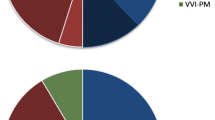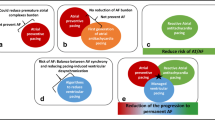Abstract
Electrophysiologic mechanisms of atrial fibrillation (AF) initiation are being actively studied. Multisite atrial pacing has shown, in acute studies, significant potential for prevention of AF. Dual site pacing reduces of intra and inter-atrial conduction time, atrial refractoriness dispersion, and to a limited extent atrial premature beats which modify the atrial remodelling induced by AF. Recently, two clinical trials have shown long term efficacy of multisite atrial pacing. At 3 years of follow-up, 56% of patients are free of AF recurrence with dual site right atrial pacing. Rhythm control was achieved in 86 of patients. Similar results are observed with biatrial resynchronization. In both studies, primary indication for multisite atrial pacing was AF prevention in more than 50% of patients. Selection of patients based solely on long P wave duration and prolonged interatrial conduction is not necessary as clinical outcome and comparable. These patients are comparable to patients who did not have these characteristics. Ongoing multicenter trials will likely definitively answer this question. However, preexcitation of diseased atrial regions or site of ectopic activity previously selected by high density atrial mapping or suppression of inducible AF may offer an interesting future development of multisite atrial pacing.
Similar content being viewed by others
References
Prakash A, Saksena S, Hill M, Krol RB, Munsif AN, Giorgberidze I, Mathew P, Mehra R. Acute effects of dualsite right atrial pacing in patients with spontaneous and inducible atrial flutter and fibrillation. J Am Coll Cardiol 1997;29:1007–1014.
Prakash A, Delfaut P, Krol RB, Saksena S. Regional right and left atrial activation patterns during single-and dualsite atrial pacing in patients with atrial fibrillation. Am J Cardiol 1998;82:1197–1204.
Daubert C, Mabo Ph, Berder V, Gras D, Leclercq C. Atrial tachyarrhythmias associated with high degree interatrial conduction block: Prevention by permanent atrial resynchronisation. Eur JCPE 1994;1:35–44.
Yu WC, Chen SA, Tai CT, Feng AN, Chang MS. Effects of different atrial pacing modes on atrial electrophysiology: Implicating the mechanism of biatrial pacing in prevention of atrial fibrillation. Circulation 1997;96:2992–2996.
Attuel P, Pellerin D, Mujica J, Coumel Ph. DDD pacing: An effective treatment modality for recurrent atrial arrhythmias. PACE 1988;11(II):1647–1654.
Hesselson AB, Parsonnet V, Bernstein AD, Bonavita G: Deleterious effect of long term single chamber ventricular pacing in patients with sick sinus syndrome: The hidden benefits of dual chamber pacing. J Am Coll Cardiol 1992;19: 1542–1549
Sgarbossa EB, Pinski SL, Maloney JD, Simmons TW, Wilkoff BL, Castle LW, Trohman RG. Chronic atrial fibrillation and stroke in paced patients with sick sinus syndrome. Relevance of clinical characteristics and pacing modalities. Circulation 1993;88:1045–1053.
Lamas GA, Orav EJ, Stambler BS, Ellenbogen KA, Sgarbossa EB, Huang SKS, Marinchak RA, Estes NAM III, Mitchell GF, Lieberman EH, Mangione CM, Goldman L, for the Pacemaker Selection in the Elderly Investigators. Quality of life and clinical outcomes in elderly patients treated with ventricular pacing as compared with dual-chamber pacing. N Eng J Med 1998;338:1097–1104.
Andersen HR, Nielsen JC, Thomsen PE, Thuesen L, Mortensen PT, Vesterlund T, Pedersen AK. Long-term follow-up of patients from a randomised trial of atrial versus ventricular pacing for sick-sinus syndrome. Lancet 1997 Oct 25;350:1210–1216.
Connolly S, for CTOPP Investigators. The Canadian Trial of Physiologic Pacing. Presented at the Annual Sessions of the American Heart Association, November 1998.
Reimold SC, Lamas GA, Cantillon CO, Antman EM. Risk factors for the development of recurrent atrial fibrillation: role of pacing and clinical variables. Am Heart J 1995;129: 1127–1132.
Delfaut P, Saksena S, Prakash A, Krol R. Long-term outcome of patients with drug-refractory atrial flutter after single and dual-site right atrial pacing for arrhythmia prevention. J Am Coll Cardiol 1998;32:1900–1908.
Saksena S, Prakash A, Hill M, Krol R, Munsif A, Mathew P, Mehra R. Prevention of recurrent atrial fibrillation with chronic dual-site right atrial pacing. J Am Coll Cardiol 1996;28:687–694.
Wijffels MCEF, Kirchhof CJHJ, Dorland R, Allessie MA. Electrical remodelling due to atrial fibrillation. In: Allessie MA, ed. Atrial and Ventricular Fibrillation: Mechanisms and Device Therapy. Armonk, NY: Futura Publishing Company, 1997:215–234.
Chen YJ, Chen SA, Tai CT, Yu WC, Feng AN, Ding YA, Chang MS. Electrophysiologic characteristics of a dilated atrium in patients with paroxysmal atrial fibrillation and atrial flutter. J Interv Card Electrophysiol 1998;2:181–186.
Cosio FG, Palacios J, Vidal JM, Cocina EG, Gomez-Sanchez MA, Tamargo L. Electrophysiologic studies in atrial fibrillation. Slow conduction of premature impulses: A possible manifestation of the background for reentry. Am J Cardiol 1983 Jan 1;51(1):122–130.
Buxton AE, Waxman HL, Marchlinski FE, Josephson ME. Atrial conduction: Effects of extrastimuli with and without atrial dysrhythmias. Am J Cardiol 1984 Oct 1;54(7):755–761.
Le Heuzey JY, Copie X, Henry P, Halimi F, Lavergne T, Iliou MC, Guize L. Mécanismes de la fibrillation auriculaire, acquisitions récentes. Arch Mal Coeur 1994;87(III):41–45.
Liu L, Nattel S. Differing sympathetic and vagal effects on atrial fibrillation in dogs: Role of refractoriness heterogeneity. Am J Physiol 1997;273(2Pt2):H805-H816.
Satoh T, Zipes DP. Unequal atrial stretch in dogs increases dispersion of refractoriness conducive to developing atrial fibrillation. J Cardiovasc Electrophysiol 1996;7(9):833–842.
Wood MA, Mangano RA, Schieken RM, Baumgarten CM, Simpson PM, Ellenbogen KA. Modulation of atrial repolarization by site of pacing in the isolated rabbit heart. Circulation 1996 Sep 15;94(6):1465–1470.
Goel BG, Murgatroyd HJ. Atrial ectopic activity associated with sinus bradycardia. Circulation 1970Nov2(5):853–858.
Murgatroyd FD, Nitzsche R, Slade AK, Limousin M, Rosset N, Camm AJ, Ritter P. A new pacing algorithm for overdrive suppression of atrial fibrillation. Chorus Multicentre Study Group. PACE 1994 Nov;17(11 Pt 2):1966–1973.
Papageorgiou P, Monahan K, Boyle NG, Seifert MJ, Beswick P, Zebede J, Epstein LM, Josephson ME. Site-dependent intra-atrial conduction delay. Relationship to initiation of atrial fibrillation. Circulation 1996 Aug 1;94(3):384–389.
Mehra R, Zeiler RH, Gough WB, El-Sherif N. Reentrant ventricular arrhythmias in the late myocardial infarction period. 9. Electrophysiologic-anatomic correlation of reentrant circuits. Circulation 1983 Jan;67(1):11–24.
Daubert JC, Pavin D, Victor F, Mabo Ph. Cardiac pacing for terminating and preventing atrial flutter and fibrillation. In: Saoudi N, Schoels W, El-Sherif N, eds. Atrial Flutter and Fibrillation: From Basic to Clinical Applications. Armonk, NY: Futura Publishing Company, Inc., 1998:293–315.
Daubert C, Leclercq C, Le Breton H, Gras D, Pavin D, Pouvreau Y, Van Verooij P, Bakels N, Mabo P. Permanent left atrial pacing with a specifically designed coronary sinus lead. Pacing Clin Electrophysiol 1997 Nov;20(11):2755–2764.
Wharton JM, Sorrentino RA, Criger D, Shenasa M, Brownstein S, Derring T, Gering L, Grill C, Lee KL. Predictors of death in VVI-R and DDD-R paced patients with the tachycardia-bradycardia syndrome (Abstract). J Am Coll Cardiol 1999;33:153A.
Krol RB, Prakash A, Saksena S, Sroczynski H, Sumar R, Mackenzie P. Initial experience with an electrophysiologic strategy using a combination of atrial pacing and atrial ablation therapy for management of refractory atrial fibrillation. PACE 1999;22(II):A27 (Abstract).
Fitts SM, Hill MR, Mehra R, Friedman P, Hammill S, Kay GN, Prakash A, Webb C, Saksena S. Design and implementation of the Dual-site Atrial Pacing to Prevent Atrial Fibrillation (DAPPAF) clinical trial. DAPPAF Phase 1 Investigators. J Interv Card Electrophysiol 1998 Jun(2):139–144.
Mabo P, Daubert C, Bouhour A, on behalf of the SYNBIAPACE Study Group. Biatrial synchronous pacing for atrial arrhythmia prevention: The SYNBIAPACE study. PACE 1999;22(II):755 (Abstract).
Author information
Authors and Affiliations
Rights and permissions
About this article
Cite this article
Delfaut, P., Saksena, S. Electrophysiologic Assessment in Selecting Patients for Multisite Atrial Pacing. J Interv Card Electrophysiol 4 (Suppl 1), 81–85 (2000). https://doi.org/10.1023/A:1009878515395
Issue Date:
DOI: https://doi.org/10.1023/A:1009878515395




